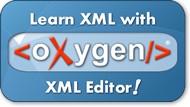XSL-FO list-block Object

Definition and Usage
The <fo:list-block> object is used to format the whole list.
There are four XSL-FO objects used to create lists:
- fo:list-block (contains the whole list)
- fo:list-item (contains each item in the list)
- fo:list-item-label (contains the label for the list-item - typically an
<fo:block> containing a number, character, etc.)
- fo:list-item-body (contains the content/body of the list-item -
typically one or more <fo:block> objects)
Syntax
<fo:list-block>
<!--
Contents:(list-item+)
-->
</fo:list-block>
|
Properties
Example 1
An XSL-FO list example:
<fo:list-block>
<fo:list-item>
<fo:list-item-label>
<fo:block>*</fo:block>
</fo:list-item-label>
<fo:list-item-body>
<fo:block>Volvo</fo:block>
</fo:list-item-body>
</fo:list-item>
<fo:list-item>
<fo:list-item-label>
<fo:block>*</fo:block>
</fo:list-item-label>
<fo:list-item-body>
<fo:block>Saab</fo:block>
</fo:list-item-body>
</fo:list-item>
</fo:list-block>
|
The output from this code would be:

Learn XML with <oXygen/> XML Editor - Free Trial!
 |
|
oXygen helps you learn to define,
edit, validate and transform XML documents. Supported technologies include XML Schema,
DTD, Relax NG, XSLT, XPath, XQuery, CSS.
Understand in no time how XSLT and XQuery work by using the intuitive oXygen debugger!
Do you have any XML related questions? Get free answers from the oXygen
XML forum
and from the video
demonstrations.
Download a FREE 30-day trial today!
|
|